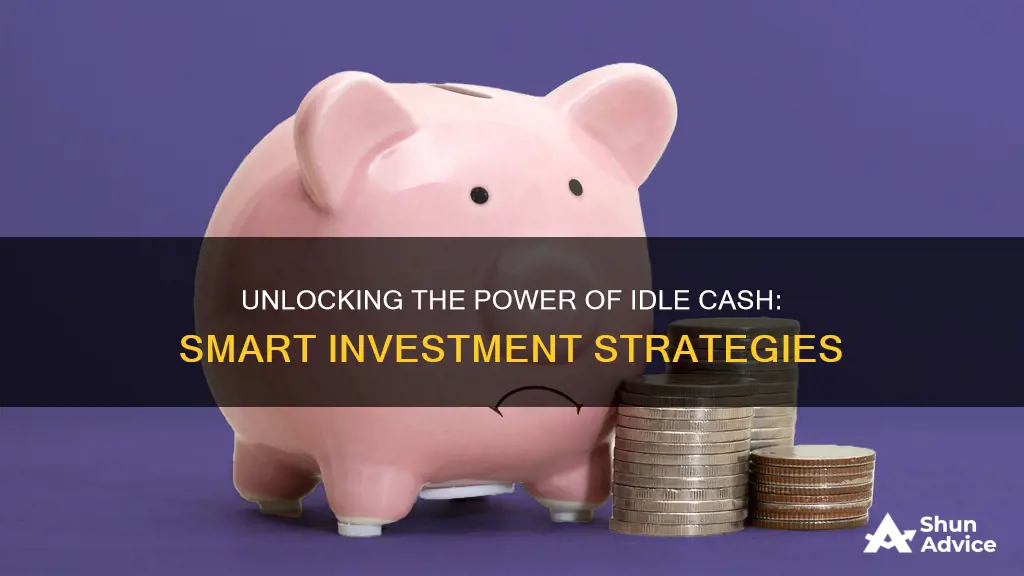
Idle cash is money that is not being used to generate profit, either through interest, dividends, or asset purchases. It is often considered wasted money as it does not appreciate in value and can even lose value due to inflation. To make the most of idle cash, individuals can invest it in money market or short-term interest accounts, while businesses can use it to purchase fixed assets, pay down debt, or invest in inventory or other short-term assets. With proper financial planning, idle cash can be transformed into a positive investment, increasing in value over time.
| Characteristics | Values |
|---|---|
| Idle cash | Cash that is not being used to increase the value of a business |
| Idle funds | Money that has not been invested and is therefore not earning interest or investment income |
| How to invest idle cash | Invest in an interest-bearing instrument, the stock market, a productive asset, or a debt or equity instrument |
| Idle cash dangers | During inflation, idle cash loses its value over time |
| How to use idle cash | Operational purchases, saving costs, boosting stock price, or holding some idle cash in a safe or checking account for regular and unforeseen expenses |
| How to avoid idle cash | Forecasting and budgeting |
What You'll Learn

Invest in an interest-bearing instrument
Idle cash is money that is not being used to increase the value of a business. It is not earning interest or generating a profit, and due to inflation, it may be losing value in real terms. To turn idle cash into a positive investment, you can invest it in an interest-bearing instrument.
Interest-bearing instruments are securities that pay interest at a specified rate, either at periodic intervals or at maturity. They are a class of financial instrument where the investor lends money to a company or institution, which pays back interest over a prescribed period. These instruments can be issued by a range of institutions, including governments, corporations, and financial institutions. The most common type of interest-bearing instrument is a bond.
Bonds are a form of debt for the issuer, representing a contractual claim over their future cash flows. The buyer of the bond lends money to the issuer for a fixed term, during which the issuer pays a fixed interest rate at prescribed intervals, and repays the principal amount at maturity.
Another example of an interest-bearing instrument is a Certificate of Deposit (CD), which is a guaranteed investment in the US. CDs have a lock-in period during which the funds are not redeemable, but they often pay the highest interest rates among savings accounts and investments.
Interest-bearing instruments differ from discount instruments, where the return is earned by the increase in the redemption amount over the initial investment. Sterling commercial paper is an example of an instrument that can be issued either in interest-bearing form or as a discount instrument.
By investing idle cash in interest-bearing instruments, individuals and businesses can ensure their money is appreciating in value, rather than losing value due to inflation.
Untaxed Cash: Investing Strategies for Discretionary Funds
You may want to see also

Invest in the stock market
Investing in the stock market is a great way to grow your wealth over time. Here's a detailed guide on how to get started:
Set Clear Investment Goals:
Be specific about your financial objectives. Consider both short-term and long-term goals, as they will influence your investment strategy. For example, you might be saving for a home, a vacation, retirement, or a child's education.
Determine How Much You Can Invest:
Assess your financial situation and decide how much money you can comfortably invest in stocks. Review your income sources, establish an emergency fund, pay off high-interest debts, and create a budget to determine your investment amount.
Understand Your Risk Tolerance:
Reflect on your comfort level with the stock market's ups and downs. Are you willing to take on higher risks for potentially greater returns, or do you prefer stability? Your risk tolerance will guide your investment choices.
Choose an Investment Account:
Select the type of account that aligns with your goals and risk tolerance. Consider the tax implications of different accounts, such as taxable accounts, tax-deferred accounts, and tax-free accounts. Evaluate account fees, commissions, and minimums when making your decision.
Fund Your Stock Account:
Choose a brokerage firm and open an investment account. You can opt for a cash account, where you pay for investments in full, or a margin account, which allows you to borrow to purchase securities. Fund your account through bank transfer, check deposit, or transfer from another brokerage.
Pick Your Stocks:
Look for stable companies with a strong track record and potential for steady growth. Consider blue-chip stocks, dividend stocks, growth stocks, or defensive stocks. You can also invest in exchange-traded funds (ETFs) or mutual funds for instant diversification.
Monitor and Review:
Stay informed about the global economy, industry trends, and the companies you invest in. Regularly review your investment goals and adjust your portfolio as needed. Remember, investing in stocks involves risks, and there is always the potential for losses.
Chipper Cash Investment: A Guide to Getting Started
You may want to see also

Put it in a savings account
If you're looking to invest your idle cash, one option is to put it in a savings account. Savings accounts are a good way to keep your money liquid while still earning some interest. They are also a relatively safe investment option, as your money is typically insured by the bank or financial institution.
When choosing a savings account, it's important to consider the interest rate offered. While savings accounts typically offer lower interest rates than other investment options, some banks may offer higher interest rates depending on the balance maintained in the account. It's also important to consider the liquidity of the account, as some savings accounts may have limitations on the number of withdrawals or transactions allowed.
To get the most out of your savings account, it's a good idea to shop around and compare interest rates offered by different banks. Additionally, look for accounts with low fees or set amounts of free transactions. Another option is to consider a high-interest savings account, which offers higher interest rates but may have more restrictions on withdrawing your money.
It's worth noting that leaving idle cash in a savings account can result in missed opportunities for higher returns through other investments. However, savings accounts can be a good option for temporary surpluses or for routing investments and meeting expenditures. They can also be useful for parking money that you don't need immediate access to, as it can be easily withdrawn when needed.
Schwab's Cash Investment Options: What You Need to Know
You may want to see also

Buy corporate or government bonds
If you're looking to invest your idle cash, one option is to buy corporate or government bonds. Bonds are a debt obligation, like an IOU. When you buy a corporate bond, you are lending money to the company issuing the bond. In return, the company makes a legal commitment to pay interest on the principal amount and, usually, to return the principal when the bond matures.
There are several types of bonds available for investment, including corporate bonds, U.S. Treasury bonds, other U.S. government bonds, and municipal bonds. Corporate bonds make up a large part of the U.S. bond market, which is the largest securities market globally. Companies use the proceeds from bond sales for various purposes, such as investing in new equipment, research and development, buying back their stock, paying dividends, refinancing debt, and financing mergers and acquisitions.
When considering investing in bonds, it's important to understand the maturity dates and credit quality of the bonds. Maturity refers to the date when the company has to repay the principal to investors. Bonds can be short-term (less than three years), medium-term (four to ten years), or long-term (more than ten years). Longer-term bonds typically offer higher interest rates but may come with additional risks.
Credit quality is another crucial factor in assessing bonds. Credit rating agencies evaluate the risk of default by the issuing company and assign credit ratings accordingly. Based on these ratings, bonds are classified as investment-grade or non-investment grade. Investment-grade bonds are considered more likely to be repaid on time, while non-investment-grade bonds, also known as high-yield or speculative bonds, offer higher interest rates to compensate for the greater risk.
Bonds can also differ in the type of interest payments they offer. Some bonds provide a fixed-rate interest throughout their term, known as coupon payments. Others offer floating rates that are reset periodically and adjust according to market interest rates. One specific type of bond, called a zero-coupon bond, makes no interest payments until maturity. Instead, it offers a single payment at maturity that includes the initial investment and accrued interest.
When investing in corporate or government bonds, it's important to remember that, like all investments, bonds carry risks. One key risk is the possibility of the company defaulting on its bond payments. In such cases, bondholders will have a claim on the company's assets and cash flows, with the terms of the bond determining the priority of their claim.
Best Places to Invest Your Cash Today
You may want to see also

Invest in stocks or bonds
Investing in stocks and bonds is a great way to make your idle cash work for you. Here's what you need to know about investing in these securities:
Understanding Stocks and Bonds
Stocks and bonds are two different types of securities that are often referenced together in investment planning. When you buy stocks, you're purchasing ownership stakes in a company, while with bonds, you're loaning money to the bond issuer, typically a company or government agency. Stocks offer the potential for higher returns but come with higher risks. On the other hand, bonds generally provide more reliable returns and are better suited for risk-averse investors.
Advantages of Stocks
Stocks have the potential to generate higher returns over time. As a company's performance and profits increase, its share prices can also increase, leading to capital gains for investors. Additionally, many companies pay dividends, which are distributions of profits to shareholders. Dividends can be reinvested in the company to purchase more shares. Stocks are also highly liquid, allowing investors to buy and sell them quickly and easily.
Disadvantages of Stocks
The main disadvantage of stocks is their higher risk. Share prices can fluctuate and decline if a company's performance decreases. Investors may lose a portion or even all of their investment if a company goes bankrupt. Other factors that can impact stock prices include economic conditions, political and social risks, changes in consumer behaviour, and competitor actions.
Advantages of Bonds
Bonds offer more stable and reliable returns compared to stocks. They have a fixed maturity date when the loan is repaid in full, along with interest payments. Bonds can help create a balanced portfolio, especially for investors who are risk-averse or approaching retirement. The interest payments from bonds provide a steady stream of fixed income over the life of the loan.
Disadvantages of Bonds
One of the main disadvantages of bonds is the potential risk of default, where the borrower may be unable to repay the loan. While less common with high-quality bonds, it is a risk to consider. Additionally, interest rate changes can impact bond prices. When interest rates increase, bond prices tend to decrease, and vice versa.
Diversification
To mitigate risks and optimize returns, it's generally recommended to diversify your portfolio by investing in both stocks and bonds. This allows you to take advantage of the higher return potential of stocks while benefiting from the relative safety of bonds. The combination of these two asset classes can provide increased stability and help you achieve your investment goals.
Cash Flow Notes: A Smart Investment Strategy
You may want to see also
Frequently asked questions
Idle cash is money that is not being used to generate profit, either through interest, dividends, or investments. Idle cash is often thought of as "wasted" money as it does not appreciate in value and can even lose value due to inflation.
Idle cash can be invested in an interest-bearing account, such as a high-yield savings account, or in the financial markets. For businesses, idle cash can be used to invest in new machinery, plants, or other fixed assets to boost production capacity.
Idle cash can lose value over time due to inflation, resulting in a decrease in purchasing power. For example, if you hold $100 in cash, it may only be worth $95 in terms of purchasing power a year later due to inflation.
Instead of holding idle cash, individuals can invest in money market accounts, short-term interest accounts, or other types of investments such as stocks, bonds, or mutual funds. Businesses can use idle cash to pay down debt, buy back stock, or invest in assets that improve productivity, such as machinery or inventory.







